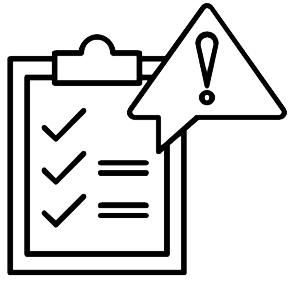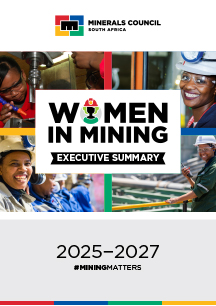The Women in Mining (WiM) initiative seeks to enhance the representation and development of women in the mining industry. With a roadmap and priority initiatives underway, the WiM cohort is implementing seven foundational measures to maintain momentum and drive this process forward.
Seven foundational measures
1
Reaffirm Zero Tolerance for Gender-based Violence and Femicide (GBVF) through ‘Stop Abuse’ campaign
Aim:
Propose a strategy on GBVF for industry to implement.
Actions:
- Members of the Women in Mining Leadership Forum and the working Group, the Women in Mining Task team recognise the scourge of GBVF in South Africa and in the mining industry. Through a collaborative effort, members have crafted a dynamic and consolidated strategy for implementation by member companies. The stated actions emanating from the strategy are implemented at mining company level and also include collaborations with key stakeholders within the sector and in civil society to ensure real impact.

2
Develop Gender Diversity and Inclusion Policies
Aim:
Provide a framework for the mining sector towards realising its commitment to gender equality, diversity and inclusion, integrating gender equity into its policies, structures, systems and operations.
Actions:
- The South African legislative and regulatory landscape provides an enabling framework to ensure decent work for all and to foster a diverse and inclusive world of work. It is within this context that the Minerals Council Policy Framework was developed, to provide guidance to member companies and articulate the strategy and stretch targets to be achieved for women’s representation in the mining industry. The Policy framework, which is reviewed periodically to ensure it is in-line with local and international regulations and policy, is a dynamic document that members may refer to when crafting their internal policies as they relate to diversity equity and inclusion.
3
Provide Reporting System for Gender Diversity Issues
Aim:
Develop a data collection system for Minerals Council Member companies to report on gender diversity metrics. The data collected at industry level provides an indication on the progress made in furthering the transformation of the industry.
Actions:
- The WiM Gender Diversity and Inclusion Dashboard was launched in August 2021. The following metrics have been identified as key levers to further transformation and they form the main themes that are tracked on the Dashboard:
- Policies
- Culture
- Career progression/management
- Reward and recognition
- Learning and growth
- Safety

4
Initiate Unconscious Bias Training to Transform Culture
Aim:
Develop a framework to address unconscious bias in mining and devise strategic guidelines and materials to assist companies in tackling unconscious bias.
Actions:
- The WiM working group has developed a framework to assist companies in the efforts to address unconscious bias. A training video and an interactive e-booklet have also been produced as training aides as they conscientise employees on unconscious bias and its effects.
5
Deploy Ongoing Companywide Pulse Check Surveys
Aim:
Propose a strategy to address companywide pulse check surveys.
Actions:
- Pulse check surveys are a crucial part of ensuring that an enabling and healthy working environment is created for all to thrive and realise their full potential. Within the mining industry, these are also useful mechanisms to obtain insights into programmes and initiatives to be implemented to further the transformation of the sector. Through the WiM Initiative, periodic Pulse Check surveys are conducted as part of the strategy and to also obtain data on key Diversity Equity and Inclusion metrics.

6 & 7
Build Inclusive Physical Environment, PPE for Women
Aim:
Propose a guideline whereby appropriate PPE, built physical environment and the general mental health and safety of women are in place at all mines.
Actions:
- Mining is a dynamic environment which also presents a myriad of safety hazards due to the unpredictability of nature, the use of machinery, heavy tools, and mobile haulage to extract and transport materials.
Further to this are the added stressors that women face such as physical violence, sexual harassment, bullying, performing physically demanding task and many other challenges that impede on their psychological and physical wellbeing. Mine Health and Safety Act No. 29 of 1996 and its amendments as well as the Occupational Health and Safety Act 85 of 1993 provide for a legal framework to ensure the health and safety of all employees on the mines. However, beyond this, we recognise that there may be gaps in legislation, policy, and practice that manifest as constraints or challenges directly impacting women in mining. Therefore, deriving from regulation and best practices by members in the sector and as guided by international conventions, we continue to develop and craft dynamic guidelines, strategies and practices that are gender sensitive and create a safe and inclusive working environment.


